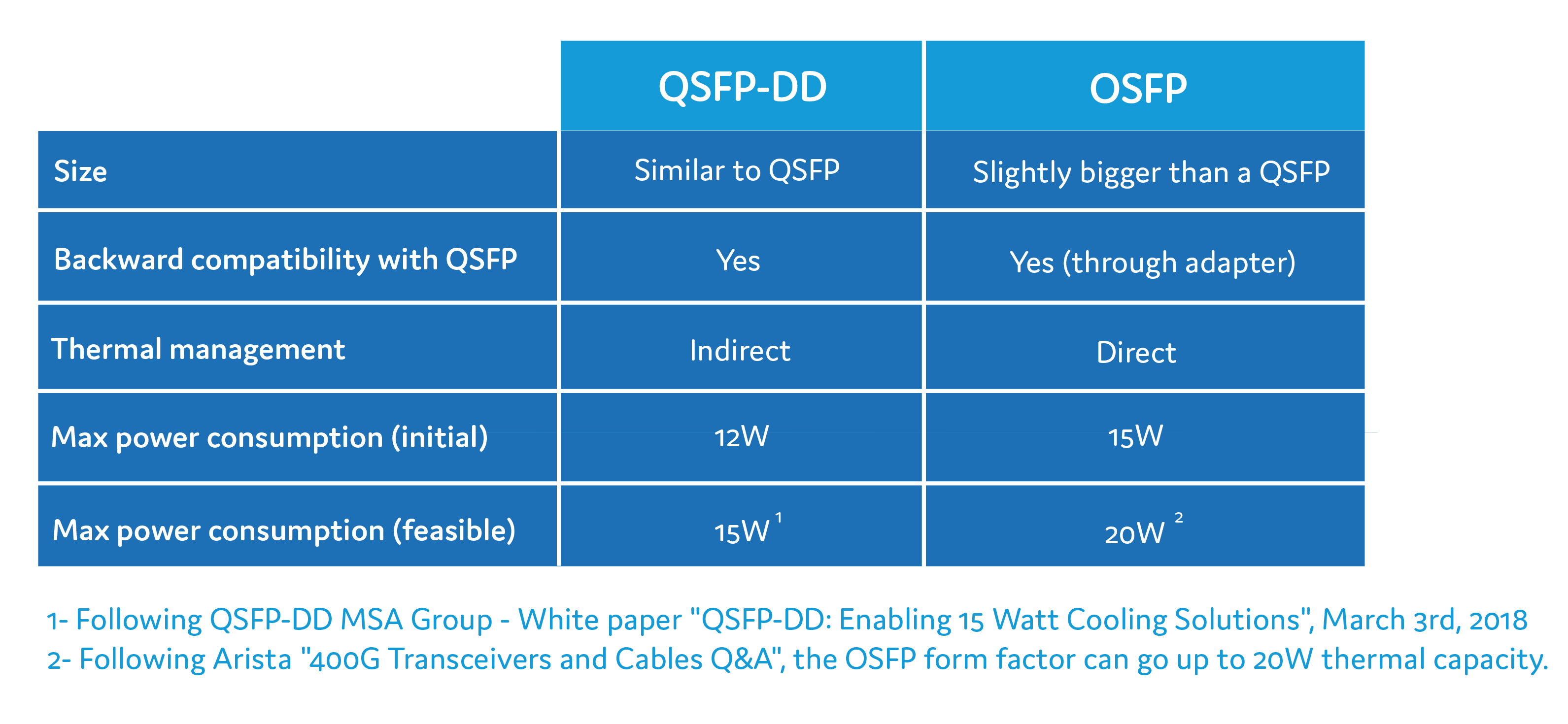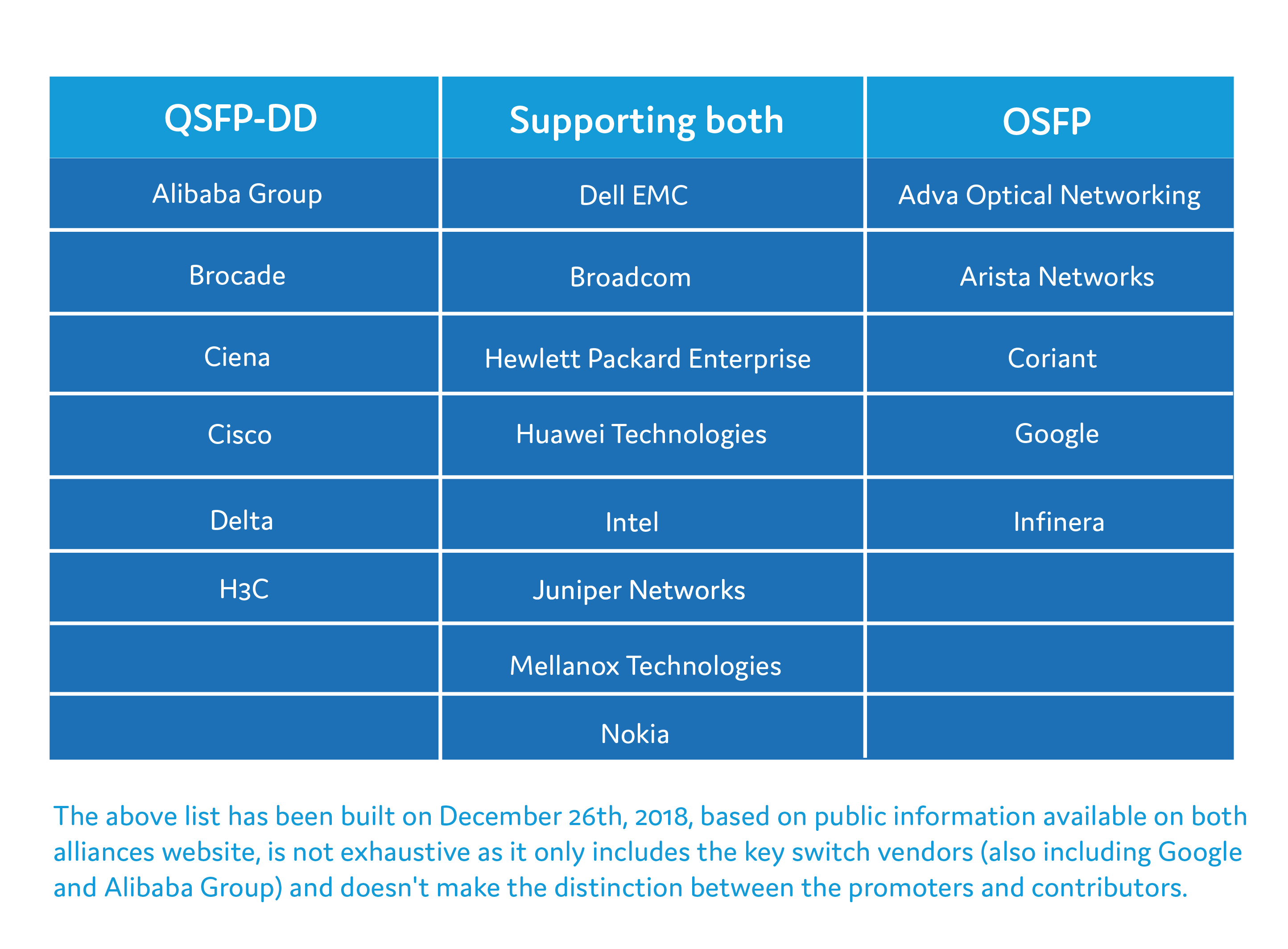While there are multiple form-factors for 400G bitrates (see our blog article: "400G - Which form factor?"), the QSFP56-DD and OSFP are clearly in competition for all "access" and "data-centre" applications.
QSFP-DD and OSFP Specifications
QSFP56-DD - stands for QSFP56 Double Density - 4x (quad) 50G x2 (double density) = 400G
The QSFP56-DD, also called 400G QSFP-DD, is standardised by the QSFP-DD MSA Group (http://www.qsfp-dd.com/). It has a similar size compared to the QSFP transceiver (QSFP+/QSFP28/QSFP56) but it has 8 data lanes instead of 4, reason for the "Double Density" name.
The QSFP-DD port (the cage) is backward compatible with the QSFP transceiver: we will be able to plug a QSFP28 into a QSFP-DD port (if the switch support it).
While there is no direct thermal management mechanism (no integrated heat-sink), the QSFP-DD allows a maximal power consumption of 12 watts (initial spec), challenging the transceiver industry to release a 400G technology not exceeding that. Recently, the QSFP-DD MSA Group has published an application note confirming the 15W feasibility, while the last specification (in its version 4.0) defines a Power Class 7 (up to 14W) and a Power Class 8 (>14Watts).
OSFP - stands for Octal SFP - 8x 50G =400G
The OSFP is standardised by the OSFP MSA (https://osfpmsa.org/). Its size is slightly bigger than a
QSFP module and is designed for 8 data lanes, actually reaching 400G bitrates (with 50G PAM4). It
has a direct thermal management (integrated heat-sink) and allows a maximum power consumption
of 16 Watts, relaxing the requirements for the transceiver industry. The OSFP cage backward-
compatibility toward QSFP module is only feasible with an adapter.
Arista Networks, a promoter of the OSFP, also claims that OSFP can go up to 20 Watts thermal
capacity, opening the door for Coherent DWDM transmission.

The key names behind the 2 form factors
Interestingly, key companies are behind the QSFP-DD MSA Group and OSFP MSA, while some are supporting both standards:

At the release date of this article, some switch vendors have announced/released "400G ready" switches with either QSFP-DD or OSFP ports*:
- Arista - 7060DX4-32 supporting OSFP and 7060PX4-32 supporting QSFP-DD
- Cisco - Nexus 3K and 9K supporting QSFP-DD
- Edgecore - AS9716-32X supporting QSFP-DD
- Huawei - NetEngine 9000 - 8*400G-QSFP-DD supporting QSFP-DD
- Juniper - PTX10003, QFX 5220 and QFX10003 supporting QSFP-DD
- Nokia - 7750 SR supporting QSFP-DD
* the list is not exhaustive and is likely to change rapidly and frequently.
1U Rack - 32 or 36 ports?
Both QSFP-DD and OSFP remain "compact" for access and data-centre applications. However a 1U rack can handle maximum 32x OSFP ports, while the same rack can handle 36x QSFP-DD ports. More density with QSFP-DD but also more challenges in term of power dissipation.
800G ready?
The 800G bitrate (8x 100Gbps PAM4) will be available on the OSFP form factor as it has been designed for. A QSFP-DD, called QSFP112-DD, will potentially be released for 800G application. It will have the same dimensions as QSFP56-DD but the electrical interface will be optimised to support 112Gbps bitrate (100G PAM4) per lane.
Conclusion
While a trend is clearly visible, it is still too early and dangerous to define a winner. The QSFP-DD has a real advantage of being natively backward compatible with the QSFP form factor, while the OSFP seems to have more robustness (heat dissipation, space for components and 800G ready).
Except for Arista's customers, the network operators will decide the form factor when selecting the switch vendor… and it will be QSFP-DD. Actually, only Arista has released a switch with OSFP ports.
But, the situation can drastically change: the switch vendors are in the early stage of releasing the 400G switches; we have seen only few demos and some announcements but not more. The first half of 2019 will probably be key to observe other announcement, to confirm or infirm the actual trend.
You are an Arista customer and you doubt about going to OSFP or QSFP-DD?
Because the OSFP has more space and less power restriction, the transceiver industry will use this form factor for the first instances of complex technology (more than 2km, DCI application, etc.) but will rapidly support the same technology on a QSFP-DD. The early-adopters might prefer the OSFP for this reason.
If we follow the actual trend, it seems that the switch vendors are going for QSFP-DD, even Arista is coming with a dedicated version… backward compatibility, lowest power consumption and smallest form factors are key drivers for a long-term adoption.
